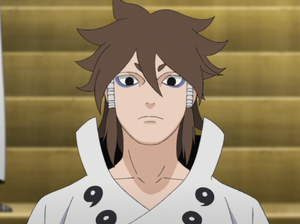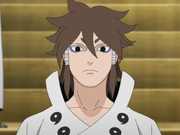WindStar7125 (talk | contribs) mNo edit summary |
No edit summary Tag: Visual edit |
||
| Line 1: | Line 1: | ||
{{Infobox}} |
{{Infobox}} |
||
| − | {{translation|'''Indra Ōtsutsuki'''|大筒木インドラ|Ōtsutsuki Indora}} was the elder son of [[Hagoromo Ōtsutsuki]] and |
+ | {{translation|'''Indra Ōtsutsuki'''|大筒木インドラ|Ōtsutsuki Indora}} was the elder son of [[Hagoromo Ōtsutsuki]] and his descendants later became the [[Uchiha clan]]. |
== Background == |
== Background == |
||
Revision as of 05:26, 26 December 2014
| editIndra Ōtsutsuki | |||
|---|---|---|---|
 | |||
| 大筒木インドラ Ōtsutsuki Indora
| |||
| Debut | |||
| Manga | Naruto Chapter #462 | ||
| Anime | Naruto Shippūden Episode #203 | ||
| Novel | The Last: Naruto the Movie | ||
| Movie | The Last: Naruto the Movie | ||
| Game | Naruto Shippūden: Ultimate Ninja Impact | ||
| Appears in | Anime, Manga, Novel, Game, Movie | ||
| Voice Actors | |||
| Japanese |
| ||
| English |
| ||
| Personal | |||
| Birthdate | |||
| Sex | |||
| Species | Celestial Being-Human hybrid | ||
| Status | Deceased | ||
| Kekkei Genkai | |||
| Classification | |||
| Affiliation |
| ||
| Clan | |||
| |||
| |||
| |||
| |||
Indra Ōtsutsuki (大筒木インドラ, Ōtsutsuki Indora) was the elder son of Hagoromo Ōtsutsuki and his descendants later became the Uchiha clan.
Background
Indra and Asura with their father.
Indra was the first son of Hagoromo, inheriting his father's eyes: his dojūtsu powers (Sharingan), powerful chakra, and spiritual energy. From a young age, he demonstrated great talent towards ninshū and anything he applied his mind to. Because of his prowess, he led a solitary life — finding no need to depend on others. When Hagoromo was on his deathbed, he selected Indra's younger brother, Asura Ōtsutsuki, to carry on his dream of establishing peace throughout the world.
Black Zetsu manipulating Indra's ideology. |
Angry and jealous that his father had not chosen him, Indra, being tempted by Black Zetsu, fought against Asura to claim what he believed should have been his birthright. Both brothers went to their graves constantly fighting over the title of ninshū's successor. His descendants, who would become the Uchiha clan, would continue this fight with his younger brother's descendants, the Senju clan never knowing how or why their hatred of each other came to be.[3]
Personality
Indra walking his path independent and alone.
Recognising his own talents, Indra became proud and independent, determined to walk his own path unaided. He believed that force and strength were the ultimate key to peace. Although he loved his father greatly, he later came to despise both him and Asura due to the former's decision, and Black Zetsu was able to take advantage of Indra's resentment towards his brother, making Indra challenge his father's decision to let his younger brother carry on his will.[3] Despite his status as a lone wolf, Indra was apparently able to find a lover.
Appearance
Indra had long brown hair cut short on top, with two locks wrapped in bandages framing either side of his face. His eyebrows were cut short — a symbol of his nobility — and his eyes had blue markings around them, which were turned up at the corners. He wore a high-collared, light-coloured kimono held closed by a dark sash. Around the collar of the kimono was adorned with magatama under which he wore a black full-bodied suit. He was also depicted in full-body armour. He had allowed his hair to grow out flowing around his attire.
Abilities
Indra's Complete Body Susanoo.
From a young age, Indra was recognised as a natural genius and a prodigy, even in his legendary father's own perspective. In battle, Indra also wielded a sword, showing some expertise in kenjutsu. In addition to his skill in battle, Indra inherited his father's powerful chakra and spiritual energy.
Dōjutsu

The presumed pattern of Indra's Mangekyō Sharingan.
Indra possessed a derived form of his grandmother's dōjutsu; the Sharingan. He would also awaken its advanced form: the Mangekyō Sharingan which is presumably the spiral-like pattern that originated from his pupils and covered his irides, which was shown when he debuted.
With it, he became the first known wielder of Susanoo. Attaining mastery over the technique and its various developments, he became capable of fully manifesting and "stabilise" it into its Complete Body form, dwarfing the surrounding landscape.[4]
Legacy
Indra reincarnated in Madara.
Hagoromo noted that Indra's chakra remained after his body was destroyed and it was reincarnated into various individuals through history. Madara Uchiha, the previous reincarnation, helped create the first ninja village with Asura's reincarnation, Hashirama Senju. However, Madara eventually adopted Indra's ideology, due to various occurrences and continuously sought more power. His growing ambition led him to covet, and eventually steal Hashirama's DNA, inadvertently gaining a portion of Asura's chakra and implanting it in himself. As a result of this, Madara awakened the Rinnegan. After Madara's death, Indra was reincarnated into Sasuke Uchiha.
According to Black Zetsu, the reincarnations of Indra and Asura are almost always in conflict with each other and rarely work together. Naruto and Sasuke are one of the exceptions, assuming other exceptions have existed throughout the centuries.
Trivia
- "Indra" literally means "King of Gods" in Sanskrit.
- The rivalry of Indra and Asura and their descendants (Uchiha and Senju) is derived from Hindu and Buddhist religions where the Gods, led by Indra, are in constant battle against the Asuras.
- Indra's deep hatred toward his brother, a result of his father choosing the latter as the successor of ninshū, may have transcended down throughout his lineage and become part of what is known as the "Curse of Hatred".
- Like his father, he wielded a sword in battle. His choice of weapon could represent his lust for power, while his brother's choice of a shakujō could symbolise his desire for love and peace.

